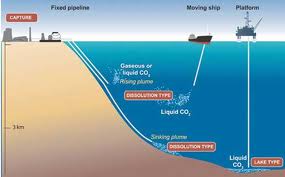Carbon sequestration and capture is the process of removing carbon dioxide from the atmosphere and putting it into long-term storage. This method can largely reduce the carbon dioxide emissions into the atmosphere. While some naturally occurring biological processes ensure the carrying out of carbon sequestration from the atmosphere on their own, it is also being executed deliberately, either by exploiting natural sequestration processes or using entirely artificial ones.
Carbon dioxide capture and sequestration (CCS) can be applied to power plants and other industrial facilities, including coal-powered power plants, power stations, natural gas processing plants, etc. Many CCS technologies presently exist and have an efficiency of about 80-90%. These can drastically reduce carbon dioxide emissions into the atmosphere.
From the many options available for the sequestration of carbon dioxide, it is important to choose the right one or the right combination of multiple. Broadly sequestration can be divided into biotic and abiotic sequestration.
Abiotic C sequestration comprises physical and chemical processes along with engineering techniques without the interference of living organisms. Theoretically, abiotic sequestration has a much larger capacity than biotic sequestration.
Oceanic injection is one abiotic CCS method. It involves injecting a pure stream of CO2 deep into the ocean. The liquefied carbon dioxide separated from industrial sources must be injected at great depths to be stable and to avoid outgassing. There are a number of options to carry out oceanic injection. The liquefied carbon dioxide can be injected below 1000 m which will later rise to a depth of thousand metres as it is lighter, or it can be injected as a denser CO2-seawater mixture at a higher level in the sea which will later sink lower. It could also, as an alternative, be discharged from a large pipe being towed behind a ship. The concept of oceanic injection has garnered a growing interest since its initial proposal. However, it may have adverse biological effects and there are still economic issues related to it that need to be resolved.
Geological injection, another possibility, is principally the same as oceanic injection, except that instead of the sea bed, the carbon dioxide in liquefied form is to be injected into the deep layers of the geological strata underground. This process can also be used for enhanced oil recovery (EOR) as it is being used in places like Texas and Norway, because it displaces any existing oil or gas from the reservoir into which it is being injected. Concerns with this method are also mostly the same as the problems with oceanic injection i.e. leakage and cost. The reactions that the CO2 may have with geological formations also need to be considered.
A third course of action within abiotic sequestration is scrubbing and mineral carbonation. As the name suggests, carbon dioxide is converted into compounds such as magnesium carbonate or calcium carbonate and other thermodynamically stable carbonates. It consists of two phases. The first is scrubbing, the most widely used method to capture carbon, which involves the absorption of CO2 with the help of a carbonate solvent. In the second stage the carbon dioxide is precipitated into a carbonate which is in the form of a stable rock in which carbon dioxide can be stored forever.
Now moving on to biotic sequestration, which consists of two main possibilities. The first is oceanic sequestration. Many biological processes leading to carbon capture and storage occur of their own accord in the ocean, e.g. the photosynthesis in phytoplankton. Iron fertilizes this reaction and many argue that the availability of iron could speed up this procedure.
Terrestrial sequestration is the other type. It basically involves the maintenance and spread of terrestrial ecosystems which hold a high potential for C sequestration. Afforestation and reforestation provide a large carbon sink and are important courses of action to consider. The increased number of trees and plants leads to more carbon dioxide being absorbed from the atmosphere for photosynthesis, during which the carbon is stored in the stems and roots and is used by the plant to live and grow. It seems to be the best strategy as it provides multiple benefits without having any harmful side effects on the environment. Terrestrial sequestration, though, does not store carbon dioxide but just the carbon part of it.
While biotic sequestration is much more environmentally safe and has various other advantages for the ecosystem, it has a very low carbon sink capacity. Thus, despite biotic sequestration’s low costs, abiotic sequestration could be considered a much more expedient solution. On the other hand, technological and engineering methods such as the injection of carbon deep into the sea, geological strata, coal mines, etc. have a potentially dangerous impact on the ecology. Not only are the costs sky high but also there is a very real fear of leakage or unprecedented reactions occurring in the deep layers of the Earth’s crust. Either way, the implementation of any method of sequestration will only be executed on a large scale only well into the future.

Leave a Reply